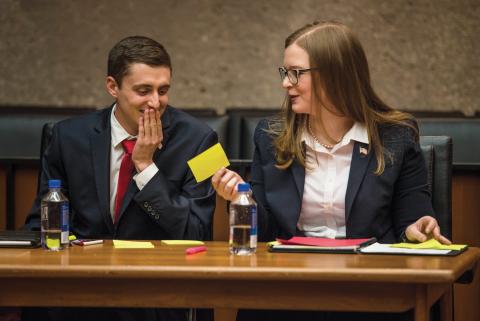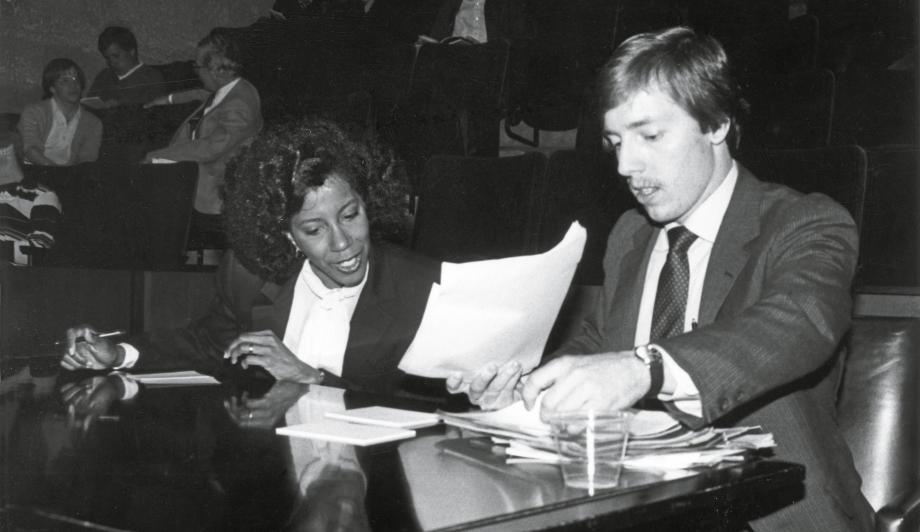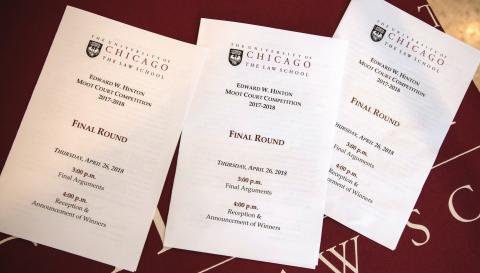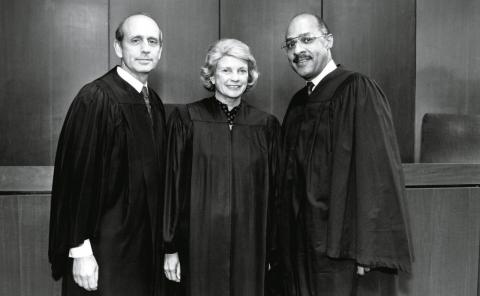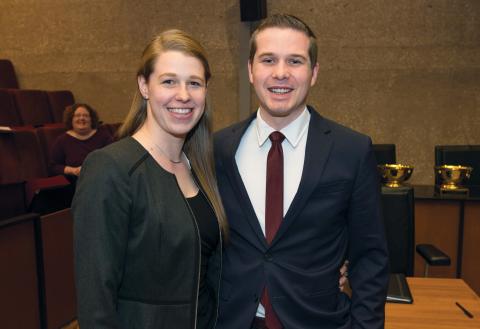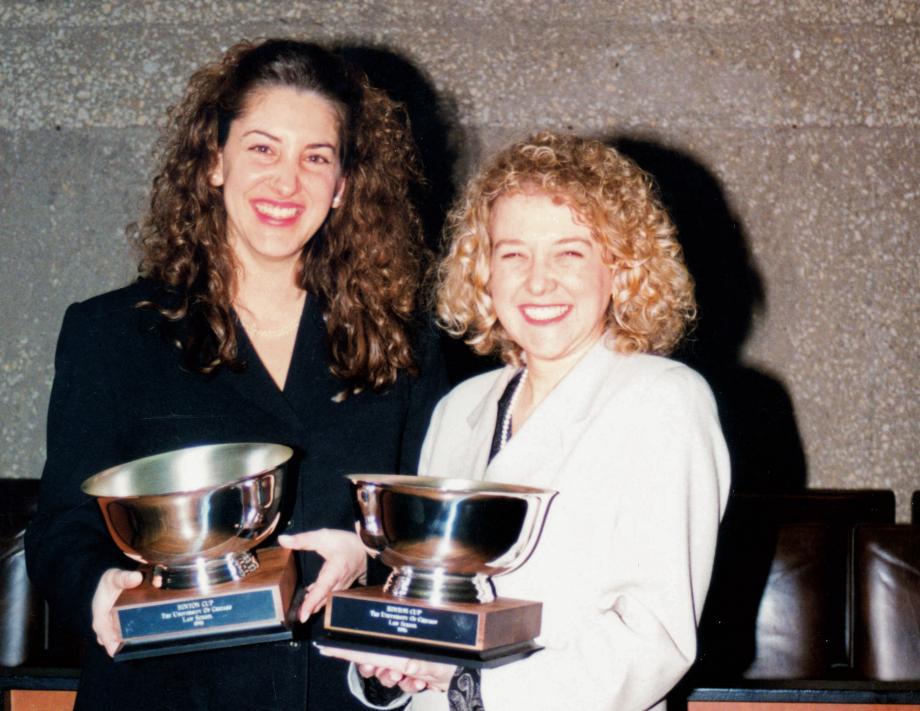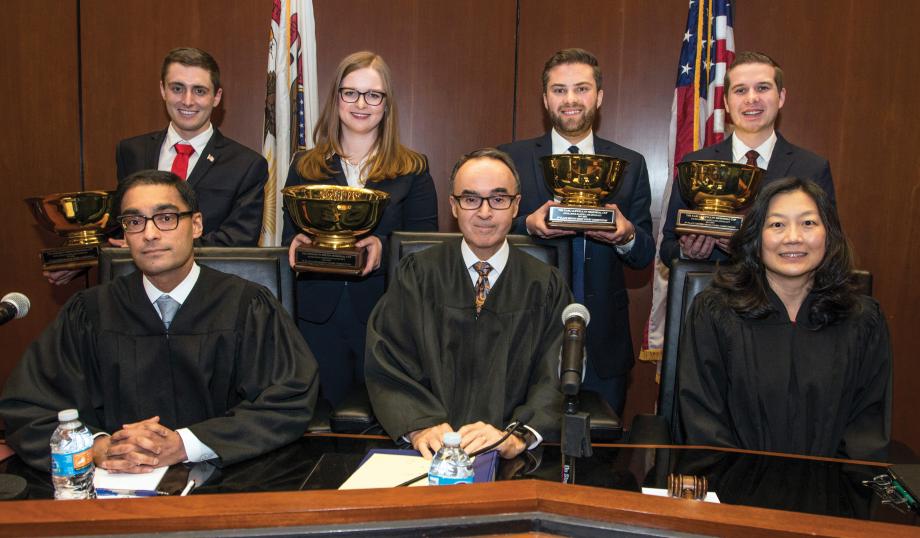The Camaraderie and Competition of the Hinton Moot Court
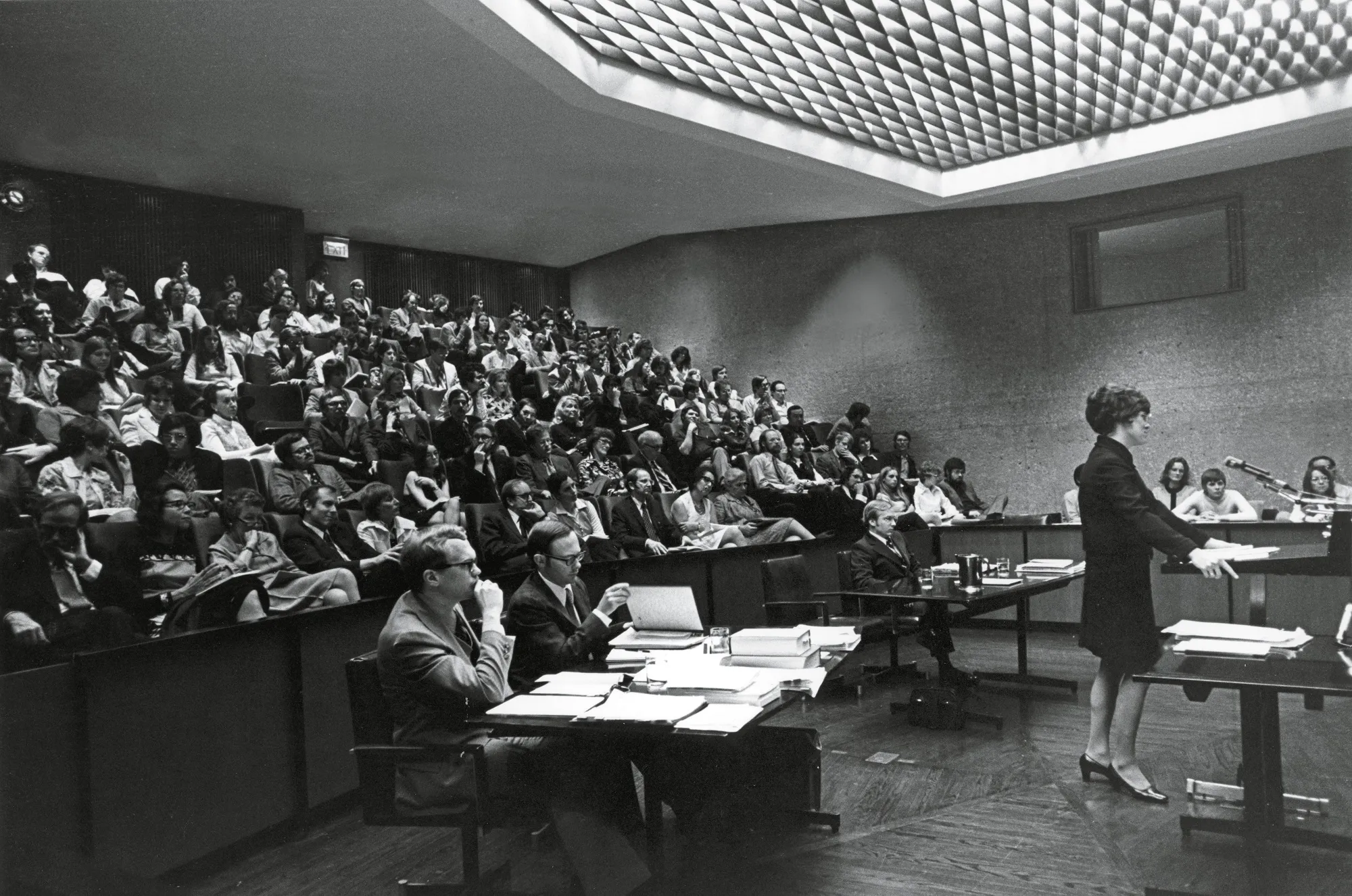
All eyes were on Andrew Hosea, ’18, as he approached the lectern in the Law School’s courtroom one afternoon last April in his navy suit and blue tie. Six months of progressive competition and two months of brief writing and oral argument practice hung in the air like, well, the weight of 100 dusky gopher frogs.
Which, by the way, is the approximate remaining population of the endangered Mississippi amphibian whose living space had occupied Hosea’s mind for weeks—along with the minds of the other finalists in the Edward W. Hinton Moot Court competition. Hosea and his partner, Samuel Johnson, ’18, and their opponents, Tate Wines and Abigail Majane, both ’18, had spent much of spring quarter immersed in Weyerhaeuser Co. v. US Fish and Wildlife Service, a pending US Supreme Court case centering on the federal government’s decision to designate privately owned Louisiana forest as “critical habitat” even though the rare species isn’t actually in residence.
It was a technical case featuring questions about statutory interpretation and judicial review—a bit more arcane than Carpenter v. US, the cell phone privacy case that Hosea and 55 other competitors had faced in the preliminary rounds that fall, or National Institute of Family and Life Advocates v. Becerra, the free speech case the 14 semifinalists had argued in February.
But it fit the major requirements for the final Hinton round: it was an actual Supreme Court case with two discrete questions, one for each half of the team. The real parties were still filing merits briefs, so the Hinton competitors, who are only allowed to read lower-court documents, wouldn’t be tempted to seek them out. Better yet—though this wasn’t mandatory—it had little chance of triggering preconceived biases. Before this, the competitors hadn’t spent much time considering this aspect of the Endangered Species Act.
“A somewhat dry case makes sense for the finals,” Hosea said.
After all, the Hinton Moot Court competition is less about the hot-button issues of the day and more about the battle itself: a mixture of competition and camaraderie laced with the inescapable sense that winning requires something akin to jumping fully clothed into the middle of a choppy lake and, through some combination of perseverance and creativity, swimming to shore.
“The deep dive and the full commitment to the project is the greatest lasting legacy and impact of moot court,” said Paul Niehaus, ’97, who argued on the second-place team 21 years ago. “It’s a great feeling knowing you’ve done everything you possibly can.”
Added his wife, Kimberly Ziev Niehaus, ’96, who argued on the first-place team 22 years ago: “It’s so intense and all-encompassing. You just didn’t do anything else . . . it was a pure intellectual pursuit.”
Although moot court teams and competitions have existed at the Law School since at least 1915, the Hinton Moot Court Competition—named for Judge Edward W. Hinton, a University of Chicago law professor between 1913 and 1936—began in 1954 as a student-run program that had Law School Professor Soia Mentschikoff as its advisor. It quickly became a Law School institution.
Clinics sometimes give students opportunities to argue in court, and various classes and moot court competitions outside the Law School offer a chance to practice litigation. But the Hinton competition is a singular experience—one that, over the years, has bred deep and abiding friendships, woven itself into romances and marriages, and left hundreds of competitors with their first real sense of what it means to argue an appellate case.
“That was the first time . . . I felt so deeply in my bones the connection with the cause and the community on whose behalf I was advocating,” said Laura Edidin, ’96, who was Kim Niehaus’s partner in the 1996 final round. “That feeling of being . . . so completely absorbed in your work . . . just lit me up inside—it made me understand that litigation was what I wanted to do.”
Hinton finalists typically argue before real judges, often federal district or appellate judges—and sometimes current or future US Supreme Court justices. Over the years, that has included Neil Gorsuch (who volunteered in 2010), Antonin Scalia (1992 and 2003), Clarence Thomas (1991 and 1999), Ruth Bader Ginsburg (1982 and 1990), Anthony Kennedy (1990), Stephen Breyer (1989), Sandra Day O’Connor (1989), Byron White (1982), John Paul Stevens (1972, 1977, and 1979), Lewis F. Powell Jr. (1978), Potter Stewart (1976), Harry A. Blackmun (1973), and William H. Rehnquist (1972).
In fact, Jeffrey B. Wall, ’03, who was on the winning team in 2003, appeared before a Supreme Court Justice—Scalia—for the first time during the Hinton finals.
“It was an unbelievable honor to be able to argue in front of him,” said Wall, who now regularly argues before the US Supreme Court as the Principal Deputy Solicitor General under another Hinton alumnus: US Solicitor General Noel J. Francisco, ’96.
Gail Peek, ’84, remembers watching the final round her 1L year when Ginsburg, then a judge on the US Court of Appeals for the DC Circuit, was part of the panel.
“She had a habit of asking questions and then saying ‘Ah ha, in that case . . . ’” said Peek, who was part of the winning team in 1983. “When participants heard that phrase, they knew they were in for a battle royal with one of the best legal minds in the country. She made such an impression on me with her apparently simple questions that eviscerated the heart of one’s argument. It was clear that she was giving the students and the audience a learning experience, [one] that I took to heart. [It was] just brilliant!”
The Hinton competition is a major undertaking. Third-year students on the Hinton Moot Court Board—finalists and semifinalists from the previous year—choose the cases, coordinate competitor sign-up, update rules, and distribute materials to the competitors. They also recruit judges for each of the three rounds, beginning with the argument-only preliminaries, which are decided by panels of Law School alumni during a two-week period in the fall. Each participant argues twice, once on each side, before what is typically a three-person panel. Many alumni judges do several consecutive rounds, but ultimately there are many dozens of spots to fill.
“It probably took about two 50-hour weeks” to prepare for preliminaries, said Elizabeth Ertle, ’18, who cochaired the 2017–2018 Moot Court Board with Julius Kairey, ’18. “I think I sent individual e-mails to about 150 alumni.”
In the winter, the 14 semifinalists, who are divided evenly between the two sides, compete on their own, writing briefs and arguing before a panel of three professors. This year, Professors William Hubbard, Anup Malani, and Sarah Konsky presided, choosing the four finalists as well as two honorable mentions (John Tienken, ’18, and Eileen Prescott, ’18), a best petitioner’s brief (Stephen Spector, ’19), and a best respondent’s brief (Hosea).
In the spring, the four finalists compete in teams of two, earning either the first-place Hinton Cup or the second-place Llewellyn Cup, named for longtime Professor Karl Llewellyn.
“During that first round, there was this wonderful feeling of community—it seemed like everyone was doing moot court, and they were all having the same experience you were,” Paul Niehaus said. During the semis, there was a different sort of camaraderie, the kind that comes with being part of a small group. “You could look at all of them and know that they, too, were spending long nights in the carrel, cranking away,” he said.
By finals, though, it was all about the team and the material, with competitors absorbing and organizing information until, as Niehaus puts it, “you had an internal sense that you knew everything you needed to know.”
And so it was with Hosea and the frog case. He read everything from the lower courts—opinions from the district court and the Fifth Circuit Court of Appeals, as well as a Fifth Circuit dissent and a petition for rehearing—and spent hours trying to reconcile different judicial interpretations.
“Sometimes it was like reading two different statutes from two different cases—like two ships passing in the night,” said Hosea, who, as the petitioner, had been assigned to argue against the critical habitat designation. “I kept thinking that it was interesting that such a talented group of judges could be so at odds with one another over something as seemingly simple as defining ‘critical habitat’ and whether or not it must be essential to the conservation of the species.”
But he read and reread the cases until they began to make sense. He crafted his arguments and chose the exact words he needed to make his points effectively. He and Johnson—who had competed in both moot court and mock trial as an undergraduate at Patrick Henry College, which has one of the top intercollegiate moot court teams in the nation—spent hours not only on their own questions but on each other’s.
“With a complicated issue, you have to make judgment calls, and it is helpful to take a step back and listen to input,” said Johnson, who prepares calmly and meticulously. “Two sets of eyes are better than one.”
By the time they arrived at the finals, Johnson and Hosea had each spent 60 or 70 hours preparing, and they were ready.
But then again, so were Wines and Majane, who sat steely eyed in navy jackets with matching American flag lapel pins before a coordinated tableau of identical water bottles, black padfolios, and green sticky notes.
“Your honors, and may it please the court,” Hosea began, his voice steady as he looked up at the judges, Manish S. Shah, ’98, of the US District Court for the Northern District of Illinois; William J. Kayatta Jr. of the US Court of Appeals for the First Circuit; and Lucy H. Koh of the US District Court for the Northern District of California.
Soon, the dusky gopher frog would be on their minds, too.
***
Earlier in the quarter, Wines and Majane had joked about making a road trip to Mississippi to take pictures with the frogs. They infused their process with humor, exchanging lighthearted banter and sending each other motivational emoji via Snapchat. (“Sometimes we talked about legal arguments, too,” Majane said, laughing.) There was some procrastination and a certain amount of joking about the procrastination.
But, the truth was, their preparations were still thorough and intense.
During the semifinals, Majane, who had participated in mock trial in college, had been swamped with other Law School commitments until close to the end. “Then I kicked into hyperdrive for 36 hours straight,” she said.
Majane is a fierce competitor who can summon blistering focus when needed, and one of her strengths is knowing what she needs to know.
“It’s strange because you become a subject matter expert, but it ends up being very specific,” she said.
She and Wines were friends before the competition, and they work well together. Wines processes the elements of an issue by creating a giant poster featuring relevant cases in different colors of pen.
“If anyone else were to see it—it’s a disaster,” he said. “But to me it’s the solution.” During the finals, he folded it up and brought it to the argument in his padfolio.
Wines tended to work in the computer lab or at home, where he could listen to 1990s hip-hop (think Eminem’s “Lose Yourself”). Majane preferred her dining room table or the second floor of the D’Angelo Law Library, where she would pull the blinds open and bathe in the natural light.
“Early on, Tate and I would see each other in the Green Lounge, and I’d say, ‘I actually haven’t looked at the case in a week,’ and he would say, ‘Me neither.’ But then once [Hosea and Johnson submitted their] petitioner’s brief, we really got to work,” Majane said. “We wrote our own sides separately, then we swapped. We basically spent three days e-mailing each other new versions every three hours.”
Competitors say there is no one right way to prepare for moot court: either a long and steady prep or a concentrated push at the end can work, depending on the person. It is impossible to predict every question the judges will ask—or what arguments or details will draw their attention, skepticism, or ire. So the best thing a participant can do is develop a solid understanding of the case and assigned position, spend time writing a strong brief, and practice.
“I’ve learned that it is OK to pause before you talk,” Wines said. “You have to trust your preparation, and just say what you know.”
Johnson has competed in so many mock trials and moot courts that he rarely gets rattled before an argument. He knows what he needs to do, and he does it.
“I read through the roadmap in my head and make sure I have my wording precise,” he said, “but that’s it.”
Peek, who served on the winning team in 1983 with Bill Engles, JD/MBA ’85, remembers that their preparation “was unstructured and based on our availability.”
“We got together and just generally talked about the case and what we thought, and we allocated responsibility,” she said. “And then we basically left each other alone for a while; there was a lot of trust and confidence.”
Peek, who came to law school after earning a doctorate in political science, felt good writing the brief, which she composed on a 25-pound Kaypro personal computer, the kind with green type on a tiny screen. She chuckled at the memory; it was such a big deal to have a portable computer in those days.
Kaitlin Beck, ’17, and her partner Joe Egozi, ’17, who won the Hinton Cup the year they graduated, experienced the intensity of both competition and camaraderie during finals prep, when fellow members of the University of Chicago Law Review jumped in to help them practice, throwing question after question at them.
Paul Niehaus benefited from what he calls “intergenerational” prep. Kim, his relatively new girlfriend and the previous year’s winner, had insisted that he participate in moot court. (“I believe her exact words were, ‘You’re an idiot if you don’t,’” he said.) She was working in New York City by then, and she and her roommate—who had competed in the Hinton semifinals in 1995—coached him over the phone, passing down wisdom from the previous years’ competition. To this day, all three can be sent into fits of laughter as they recall the inside jokes that developed during that time.
There’s a psychological aspect to the competition, too, as participants look for ways to build and telegraph their own confidence.
Johnson, for instance, likes to argue without notes. During the finals, he strode to the lectern and jumped right in.
Majane goes the opposite way. In the finals, she struck a cool demeanor as she made her way to the front and methodically arranged her notes before addressing the panel.
“I took a good 30 seconds,” she said. “It’s a gamble, but I didn’t want to look rushed or nervous.”
She paused, then added: “Of course, Sam just walked up, no notes.”
During the semifinals, Majane had managed to project confidence even after a minor mishap on Lake Shore Drive en route to the competition.
“I was super jacked up on adrenaline, and I’d just hit a traffic cone, which didn’t help,” she said. “So when I got up there, I held both sides of the podium. It looks authoritative—and nobody can tell that your hands are shaking.”
In the week before the finals, Wines and Majane spent part of every day in the courtroom, acclimating to the space. By the time the finals rolled around, they were ready to don their flag-adorned jackets and go. They spent parts of Hosea’s oral argument trading ideas via the green sticky notes.
“No legislative history!” Wines wrote at one point when one of the judges appeared to reject a point Hosea had made. Majane, who was up next, nodded. Part of being prepared means being comfortable enough to switch gears.
And so, when it was her turn, she made her slow stroll to the front.
She took her time setting out her materials.
She thought about the questions the judges had asked Hosea, the responses he’d given, the reactions they’d had to his points.
She did not mention legislative history.
***
As each of the four finalists took their turns at the front, Ertle, the moot court board cochair, kept her eyes trained on the action.
She, Kairey, and the six other members of the Moot Court Board had worked hard all year, and the competition was nearing its successful end. The judges peppered everyone with questions, first Hosea, then Majane, Johnson, and, finally, Wines. It was impossible to tell who might win. But everything, at least, was going smoothly.
Courtroom simulation had been a part of Ertle’s life for years, ever since her undergraduate days on both the moot court and mock trial teams at Patrick Henry College. Her passion had led her to law school—and, before that, to her husband.
Today was a big day for him, and she watched with pride as he walked to the lectern and delivered a strong argument, no notes.
Johnson and Ertle met during the first mock trial meeting of their freshman year at Patrick Henry; his team recruited her, and she said yes. There was a spark, which they both acknowledged. But it didn’t seem right to disrupt competition by starting to date.
“There are funky relationship dynamics on a team when you get into a relationship with one another, so we waited until the end of freshman year,” Ertle said.
Then they fell in love.
A year later they were engaged—after going up against each other in the elimination rounds at the moot court nationals—and the summer after junior year, in 2014, they married. They applied to law schools together, tallying up each matched pair as the acceptances came in. By the fall of 2015, they were settled in Chicago.
Ertle competed in the Hinton Moot Court Competition her second year—Johnson chose to wait—and made it to the semifinals.
When it was her husband’s turn and Ertle was on the board, they followed the rules to the letter: no discussing the semifinal or final cases until after he’d submitted his briefs. But once those briefs were in, the partnership they’d built alongside their relationship kicked into gear.
“I give him very honest feedback—I think I tend to be overcritical compared to other people. But there’s this established relationship there,” Ertle said. “Occasionally I’ll say, ‘That’s okay that I said that, right?’ And he’ll say, ‘Yes, yes, yes!’ He wants to do well. Sometimes the criticisms are really shallow, sometimes they’re substantive, but we talk about everything.”
Johnson doesn’t hesitate to ask to his wife the same questions over and over: Does this argument make sense? Does my reasoning line up?
“Having someone who doesn’t mind running through the arguments five times—that really helped a lot,” he said.
Kim and Paul Niehaus get that. Moot court has become a part of their relationship lore, along with the time they spent together on The University of Chicago Legal Forum, where Kim was Paul’s editor. (“We established our relationship right off the bat,” he said. “She’s in charge.”)
The Niehauses have been married for 19 years now. He practices law, and she runs learning and development for a hedge fund. They have two kids. And, as often as they’re able, they go out to dinner with Edidin and her husband, who live nearby in New York. Kim Ziev and Laura Edidin barely knew each other when they started the Hinton competition; now they’re close friends.
Over the years, the Niehauses have told the stories of moot court: how Paul brought Kim Gatorade when she got the stomach bug shortly after filing her petitioner’s brief, how Kim returned to the Law School for the 1997 finals and met her future in-laws for the first time, and how Paul had been motivated by wanting “to win a cup as big as Kimberly’s.” (His second-place Llewellyn Cup is slightly smaller than his wife’s first-place Hinton Cup.)
They have both discovered, over the years, that moot court is something one doesn’t easily forget.
And also, when paired, a Hinton Cup and a Llewellyn Cup make a fantastic chip and dip.
Laura Edidin and Kim [Ziev] Niehaus after winning moot court in 1996. Niehaus’s husband, Paul—who took second the following year—still loves this photo. “I have known Kimberly quite well for 20-some years, and I have known Laura reasonably well for 20-some years,” he said. “Neither of them has ever had a look of greater pure joy on their faces than at that moment—and I saw my wife on our wedding day.”
***
It is hard to say what stories Wines, Majane, Hosea, and Johnson will tell about the Hinton competition years in the future.
Peek, who competed 35 years ago, remembers her dad, who is now deceased, coming for the final round. Peek recalls how proud he was when she won—and how he chatted up one of the judges afterward.
“The late Judge [Robert] Bork was very friendly and said he was impressed by my presence and composure during the oral argument,” Peek said. To this day, Peek still displays her winning gavel plaque (a predecessor to the Hinton Cup) in her law firm office in Waco, Texas.
Wall remembers Professor Adrian Vermuele coming up to him after he won the finals in 2003 and saying, “You should really think about going to the SG’s office.” Which Wall did, as an Assistant to the Solicitor General, five years later.
It is possible Hosea will remember drawing the dreaded 8 a.m. slot for the semifinals—which meant rising at 4:45 a.m. the Tuesday after a weekend spent in Park City, Utah, at his best friend’s bachelor’s party. (“Not ideal,” he said later, “but it was my best friend, and I wouldn’t have missed it for the world. Besides, I guess that’s a real-life lesson in balancing personal and professional obligations.”)
Johnson may remember strategizing with his wife, or trading briefs back and forth with Hosea dozens of times.
Wines and Majane might remember their supportive emoji texts or the green sticky notes or the intensity of their preparation.
They will almost certainly remember that they won.
But more than any of that, all four are likely to remember what Paul Niehaus describes as the big takeaway from moot court: “Once you have been through this experience, you [feel like] you could go and tackle whatever other subject is out there,” he said. “You know then how it feels when you’ve mastered it, when you feel like there isn’t still a big question out there, looming.”
Contributing: Scott Jung and Stephanie Dorris
First-place Hinton Cup winners Tate Wines and Abigail Majane and second-place Llewellyn Cup winners Andrew Hosea and Sam Johnson with the 2018 final-round judges, Manish S. Shah, ’98, of the US District Court for the Northern District of Illinois; William J. Kayatta Jr. of the US Court of Appeals for the First Circuit; and Lucy H. Koh of the US District Court for the Northern District of California.
